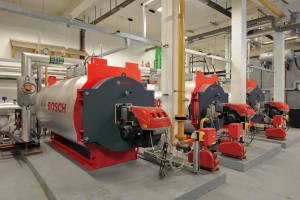Out with the old and in with the HIU

With district-heating schemes continue to grow in popularity amongst residential providers, Pete Mills of Bosch Commercial & Industrial Heating highlight the many benefits Heat interface units (HIUs) play in enhancing efficiency and simplifying maintenance.
From the late 1960s onwards, district heating schemes were at the height of popularity in the UK — particularly in apartment blocks and densely sited housing. However, this type of solution seemed to gradually fall out of fashion, particularly from the mid 1980s and onwards as combi boilers became the preference.
Over the last decade though, technology has advanced quite considerably, and the solutions available for district-heating schemes today are much improved compared to those in use 20 to 30 years ago. Also a contribution to the overall heating scheme can be made from renewable and low carbon technologies such as heat pumps, biomass and combined heat and power (CHP).
As a result, district-heating schemes are once again being considered for all types of projects and are fast becoming the heating solution of choice for local authorities and housing associations looking for better ways to save energy, reduce the CO2 footprint of their housing stock and help lower fuel bills for tenants in a bid to tackle fuel poverty.
From new build social-housing projects to large-scale refurbishments of blocks of flats and the development of existing buildings such as old hospitals into multiple dwellings, district-heating schemes are now suitable for a broad spectrum of properties. It’s perhaps not surprising then that there are currently an estimated 250 000 homes thought to be on existing district-heating schemes throughout the UK, with numbers growing all the time.
The advantages of opting for a district-heating scheme are many, but ease of installation and the ability to have greater control of these types of systems is a huge driver. According to estimates made by the Government, switching to a district-heating arrangement whereby heat interface units (HIUs) are typically installed instead of individual boilers can help deliver energy savings of between 30 to 40% compared to more traditional heating arrangements.
 |
| A high-efficiency centralised heating plant can enhance efficiency and minimise maintenance requirements. |
What’s attractive about district-heating schemes is that, from an installation point of view, no gas network, apart from a gas supply into a central plant room, needs to be piped into buildings or flats. This alone makes district heating an easier option for conversion, refurbishment and new-build projects. Removing the need for a complete gas network within a building also means removing the need for the maintenance of that system and individual boilers associated with it.
Utilising high-efficiency centralised heating plant to deliver low-carbon heating and hot water through a network of pipes to individual spaces such as apartments, the main interface with the end user in any district-heating scheme is typically provided by an HIU. These units are easier to fit than boilers, and installers do not need gas qualifications, which makes the whole process more cost and time efficient for everyone involved. After all, flue pipes and gas connections are not needed.
Other advantages of installing an HIU include minimal annual maintenance and during the lifetime of the heating system. For example, boilers in individual dwellings require annual maintenance that is far more complicated than any maintenance required by an HIU. The engineer also requires access to each and every dwelling to carry out the work.
In a typical block of, say, 200 flats this presents a huge undertaking, so removing the need for annual servicing makes perfect sense. From an installation viewpoint, there is also less disruption for tenants as it is quicker and easier to fit a distribution unit than a boiler. Another important consideration for housing associations.
As each HIU connects into a district-heating network supplied from a central plant room, an additional plus-point is that flues and ventilation routes in each dwelling are not required. This means that HIUs are simple to integrate into a new or existing building without resulting in an unsightly building with lots of flue pipes protruding out of the side of it. Siting an HIU is simpler as we are not governed by the flue permutations and maximum flue lengths of an individual boiler.
Where lots of flues have been installed in blocks of flats, other problems can arise. For example, many older kinds of blocks of flats will probably have internal U-ducts or SE-ducts. These ‘ducts’ are essentially ventilation systems where every single flue installed within a building discharges into a central shaft for the flue products to be transported to roof level and expelled into the atmosphere. Whilst this type of arrangement might have worked well with older boilers, these types of system often can’t be converted to cope with modern condensing boilers. A district-heating approach therefore helps alleviate these types of issues as well.
HIUs allow residents to have better control of the energy they use. Where older schemes were concerned, many tenants will have been used to paying a flat rate for their heat, and there is no incentive at all for people to save energy.
 |
| A heat interface unit is generally easier to fit than a boiler and can prove key to a district-heating scheme's performance. |
Lack of control can lead to overproduction of heat and people opening their windows when their flat becomes uncomfortably warm in order to dump heat. In this day and age, this is not an option. Through the installation of HIUs, residents’ energy usage can be better monitored and controlled, which can also help alleviate fuel poverty through more accurate charges being made.
As district-heating solutions continue to evolve, it is now possible to use lower temperatures for heat networks, which makes the introduction of renewable technologies more feasible. Looking ahead to the future, where densely populated areas are served by district-heating schemes, the idea of being able to connect networks together is another attractive proposition. Connecting networks could mean much better use is made of waste-heat sources in the future, helping bring energy usage and fuel costs down even further.
Because these types of systems can operate independently of fuel sources or are very straightforward to swap from one fuel type to another also means housing associations and local authorities can expect better stability when it comes to pricing. If the cost of one type of fuel starts to increase, it would be fairly straightforward to swap to an alternative source, helping alleviate rising fuel costs for all.
Given the possibilities, it’s not surprising then that the practice of district heating is once again on the increase and fast becoming a mainstream solution for flats and other multi-residential accommodation.
Pete Mills is commercial technical operations manager with Bosch Commercial & Industrial Heating.








